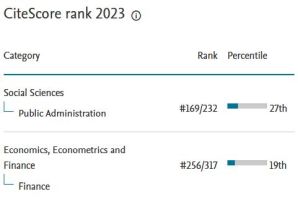A könyvvizsgálat minőségének előrejelzése
DOI:
https://doi.org/10.35551/PFQ_2025_1_4Kulcsszavak:
könyvvizsgálat, könyvvizsgálat minősége, rendszerszintű könyv-vizsgálati problémák, prediktív modellezés, PCAOB vizsgálati jelentések, Európa, M42, H83Absztrakt
Ez a tanulmány átfogó értékelést nyújt az európai könyvvizsgáló cégeket érintő, a 2013 és 2023 közötti időszakban a Könyvvizsgálói Felügyeleti Tes-tület (PCAOB) által készített ellenőrzési jelentésekről. A kutatás a rendszerszintű könyvvizsgálati hiányosságok azonosítására és a PCAOB által ajánlott beavatkozá-sok hatékonyságának értékelésére összpontosít. A tanulmány több európai ország 120 vizsgálati jelentésének elemzésével a belső ellenőrzéseket érintő, mindenütt jelenlévő problémákat tár fel, különösen az olyan területeken, mint a bevételek elismerése, a követelések elszámolása és a könyvvizsgálati dokumentáció. Vegyes módszertani megközelítést alkalmaznak, amely a többszörös regresszióelemzést és a gépi tanulási technikákat kombinálja, hogy feltárja e hiányosságok jelentős előrejelzőit, valamint a visszatérő problémákat kontextusba helyező kvalitatív meglátásokat. A megállapítások rávilágítanak a könyvvizsgálati folyamatok ösz-szetett, egymással összefüggő jellegére, és kiemelik a szilárd belső kontrollok és a PCAOB-szabványok betartásának kritikus szerepét a könyvvizsgálat minőségének javításában. Ez a kutatás azzal járul hozzá a szakirodalomhoz, hogy megvalósítható ajánlásokat tesz a könyvvizsgálati gyakorlatok javítására, így értékes felismeréseket nyújt a szabályozó hatóságok, a politikai döntéshozók és a könyvvizsgálati szakem-berek számára. A tanulmány következményei kiterjednek a szabályozási hatékony-ság növelésére és a pénzügyi beszámolás magasabb színvonalának biztosítására európai kontextusban.
Hivatkozások
Acito, A. A., Hogan, C. E., & Mergenthaler, R. D. (2018). The effects of PCAOB inspections on auditor-client relationships. The Accounting Review, 93(2), 1-35. https://doi.org/10.2308/accr-51811
Aobdia, D. (2018). The impact of the PCAOB individual engagement inspection process—Preliminary evidence. The Accounting Review, 93(4), 53-80. https://doi. org/10.2308/accr-51948
Aobdia, D. (2019). Do practitioner assessments agree with academic proxies for au-dit quality? Evidence from PCAOB and internal inspections. Journal of Accounting and Economics, 67(1), 144-174. https://doi.org/10.1016/j.jacceco.2018.09.001
Barlaup, K., Iren Drønen, H., & Stuart, I. (2009). Restoring trust in auditing: Et-hical discernment and the Adelphia scandal. Managerial Auditing Journal, 24(2), 183-203. https://doi.org/10.1108/02686900910924572
Baker, C. R., & Hayes, R. (2004). Reflecting form over substance: the case of En-ron Corp. Critical Perspectives on Accounting, 15(6-7), 767-785. https://doi.or-g/10.1016/j.cpa.2002.08.001
Bishop, C. C., Hermanson, D. R., & Houston, R. W. (2013). PCAOB inspections of international audit firms: Initial evidence. International Journal of Auditing, 17(1), 1-18. https://doi.org/10.1111/j.1099-1123.2012.00453.x
Brown-Liburd, H., Issa, H., & Lombardi, D. (2015). Behavioral implications of Big Data’s impact on audit judgment and decision making and future research direc-tions. Accounting horizons, 29(2), 451-468. https://doi.org/10.2308/acch-51023
Carcello, J. V., Hollingsworth, C., & Mastrolia, S. A. (2011). The effect of PCAOB inspections on Big 4 audit quality. Research in accounting regulation, 23(2), 85-96. https://doi.org/10.1016/j.racreg.2011.10.001
Church, B. K., & Shefchik, L. B. (2012). PCAOB inspections and large accounting firms. Accounting Horizons, 26(1), 43-63. https://doi.org/10.2308/acch-50077
DeFond, M. L. (2010). How should the auditors be audited? Comparing the PCA-OB inspections with the AICPA peer reviews. Journal of Accounting and Econom-ics, 49(1-2), 104-108. https://doi.org/10.1016/j.jacceco.2009.04.003
DeFond, M. L., & Lennox, C. S. (2017). Do PCAOB inspections improve the qua-lity of internal control audits?. Journal of Accounting Research, 55(3), 591-627. htt-ps://doi.org/10.1111/1475-679X.12151
Francis, J. R. (2011). A framework for understanding and researching au-dit quality. Auditing: A journal of practice & theory, 30(2), 125-152. https://doi. org/10.2308/ajpt-50006
Giroux, G. (2008). What Went Wrong?: Accounting Fraud and Lessons from the Recent Scandals. Social Research: An International Quarterly, 75(4), 1205-1238. https://dx.doi.org/10.1353/sor.2008.0026
Glover, S. M., Prawitt, D. F., & Taylor, M. H. (2009). Audit standard setting and inspection for US public companies: A critical assessment and recommenda-tions for fundamental change. Accounting Horizons, 23(2), 221-237. https://doi. org/10.2308/acch.2009.23.2.221
Gramling, A. A., Krishnan, J., & Zhang, Y. (2011). Are PCAOB-identified audit defi-ciencies associated with a change in reporting decisions of triennially inspected audit firms?. Auditing: A Journal of Practice & Theory, 30(3), 59-79 https://doi. org/10.2308/ajpt-10048
Johnson, L. M., Keune, M. B., & Winchel, J. (2019). US auditors’ perceptions of the PCAOB inspection process: A behavioral examination. Contemporary Accounting Research, 36(3), 1540-1574. https://doi.org/10.1111/1911-3846.12467
Kemmerer, C. H., & Shawver, T. J. (2007). Tyco: A top-down approach to ethical failure. Available at SSRN 1010558. https://dx.doi.org/10.2139/ssrn.1010558
Knechel, W. R., Krishnan, G. V., Pevzner, M., Shefchik, L. B., & Velury, U. K. (2013). Audit quality: Insights from the academic literature. Auditing: A journal of practice & theory, 32(Supplement 1), 385-421. https://doi.org/10.2308/ajpt-50350
Kukreja, G., & Gupta, S. (2016). Tesco Accounting Misstatements: Myopic Ideo-logies Overshadowing Larger Organisational Interests. SDMIMD Journal of Man-agement, 7(1). https://doi.org/10.18311/sdmimd/2016/8410
Mawutor, J. K. M. (2014). The failure of Lehman Brothers: causes, preventive measures and recommendations. Research Journal of Finance and Accounting, 5(4). https://dx.doi.org/10.2139/ssrn.2156006
Reeb, D. M., & Zhao, W. (2013). Director capital and corporate disclosure quality. Jour-nal of Accounting and Public Policy, 32(4), 191-212. https://doi.org/10.1016/j.jacc-pubpol.2012.11.003
Smith, W. L. (2013). Lessons of the HealthSouth fraud: An insider’s view. Issues in accounting education, 28(4), 901-912. https://doi.org/10.2308/iace-50542
Shroff, N. (2020). Real effects of PCAOB international inspections. The Account-ing Review, 95(5), 399-433. https://doi.org/10.2308/accr-52635
Schultz Jr, J. J., & Lopez, T. J. (2001). The impact of national influence on accoun-ting estimates: Implications for international accounting standard-setters. The International Journal of Accounting, 36(3), 271-290. https://doi.org/10.1016/S0020-7063(01)00103-0
Stefaniak, C. M., Houston, R. W., & Brandon, D. M. (2017). Investigating inspecti-on risk: An analysis of PCAOB inspections and internal quality reviews. Auditing: A Journal of Practice & Theory, 36(1), 151-168. https://doi.org/10.2308/ajpt-51518
Stuber, S. B., & Hogan, C. E. (2021). Do PCAOB inspections improve the accuracy of accounting estimates? Journal of Accounting Research, 59(1), 331-370. https://doi.org/10.1111/1475-679X.12339
##submission.downloads##
Megjelent
Hogyan kell idézni
Folyóirat szám
Rovat
License
Copyright (c) 2025 Pénzügyi Szemle

This work is licensed under a Creative Commons Attribution 4.0 International License.
Authors assign copyright to Pénzügyi Szemle / Public Finance Quarterly. Authors are responsible for permission to reproduce copyright material from other sources.











